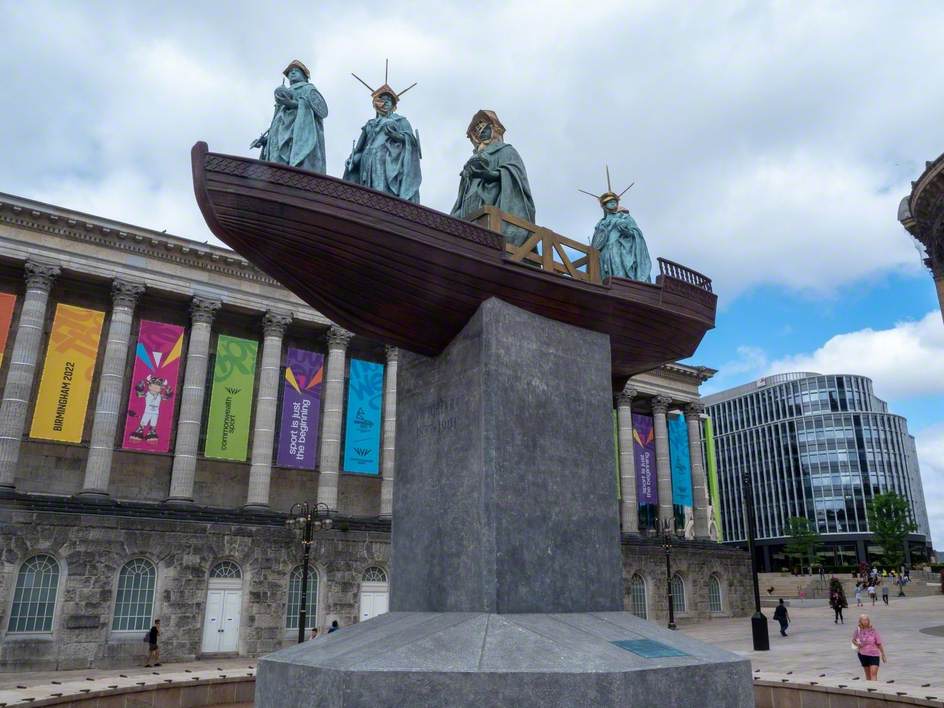Hew Locke is one of the most interesting artists working currently. Born in Edinburgh in 1959, Locke was the son of a Guyanese sculptor and a British painter. He moved to Guyana from 1966-1980 and was present for the independence of the country, greatly impacting his work. With a background in sculpture, the artist has engaged with colonial statuary and created pieces on a monumental scale, guaranteed to grab your attention. He is important with regards to how we are rethinking public spaces, and is against the removal of statues, stating in an interview that we need to open the conversation about them rather than destroy them. Over the years the artist has managed to develop his ideas and create some beautifully haunting, compelling, and thought-provoking pieces across the world. Locke exhibited some of his most engaging works in 2022, which are the focus of this article
The Procession
Commissioned by the Tate Britain, the procession is Locke’s most visually overwhelming piece. The work consists of colourfully dressed masked characters in action throughout the museum’s great corridor. The Tate museums are known for their commissions and have collaborated with artists to create politically engaging pieces such as Kara Walker on Fons Americanus, any many other figureheads of anti-colonialist art. The space is perfect as the viewer can walk alongside these human-scale characters and feel this sense of unity. The Procession contains many allusions to colonialism, combining elements of the military, nationalism, and capitalism. Locke was present for the creation of the Guyanese flag along with the independence of the country, showing that he is aware of the longstanding social impacts that a society can have after being colonised. He demonstrates this through this epic poem of a piece, showing a complex society that is still moving forward, in a work that seems to almost roar with the sound of the crowd. This piece will be moving to the Baltic in Newcastle from the 18th of February to the 11 of June 2023, and I would highly recommend seeing it.
Foreign Exchange
In this work, Locke modified a statue of Victoria in Birmingham, a symbol of colonialism which the artist would have seen on his way to school and work while grown up in Guyana. He added four other smaller replicas of the queen around her and built a boat, as though they are about to be shipped off around the world. The addition of helmets indicates the idea of war that comes with imperialism, reminding the viewer of its militaristic and violent elements. Locke furthers this by the addition of detail that recall past battles during Britain’s colonisation. For instance, one reminds us of the Benin bronzes, previously in the British Museum, which have now been returned to Nigeria. In a time where statues related to slave traders have come into debate, this is potentially a different way of coming to a middle ground, one where the statue remains but is modified. Locke’s work engages us with the present through exaggerated and eye-catching pieces, allowing anyone to access the conversation on our postcolonial present. In keeping and altering this piece it has created more awareness about movements such as Black Lives Matter and invites its audience to reconsider our current society.
Gilt
The work was another commission, this time from the Metropolitan Museum in New York, and will be at the front of the museum façade until the end of May. The confronts the Met’s collection, engaging with its array of artefacts collected from colonialism. Gilt is a play on words, combing the idea of the guilt from colonialism and the exploitation of resources from these colonies for gold in this specific case. These four trophy-like sculptures are massive, catching the eye of anyone passing by, but still provoke discussion with their more disturbing details alluding to the abuse of imperialism. One features allusions to objects looted by the East India Company in the 18th Century, with images of the tiger designs on the gun previously owned by Tipu Sultan who had fought in the 1700s against the East India Company. Two of these pictures are fractured and allude to spolia, showing the empire taking ravaged pieces of gold from a nation. The pieces ask us to engage with our environment and look more deeply at museum collections in a time where previously colonised countries are demanding the return of their artefacts.
Locke’s work gives us hope. There is a sense of chaos in his pieces, reflecting the disturbing elements of our post-colonial world, and how past imperialism still heavily impacts our present. Still there is a movement forward and a sense of unity, which strongly resounds in The Procession.


